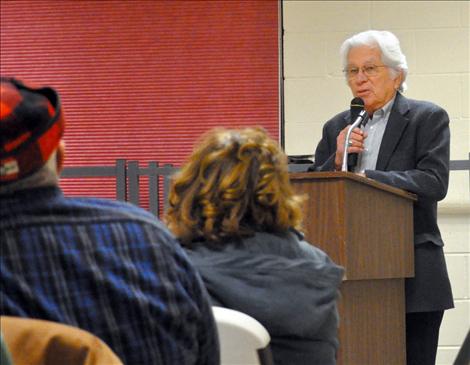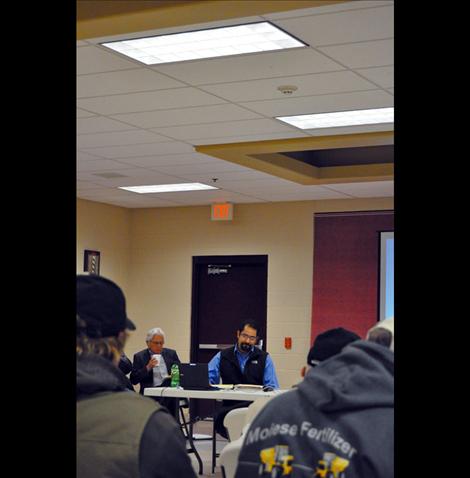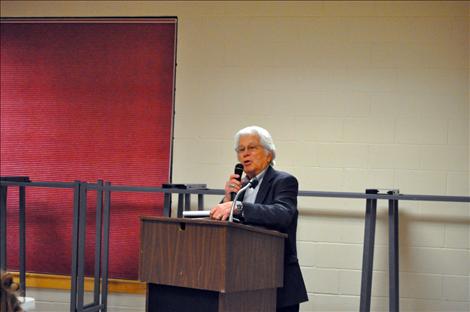Bull trout, lawsuits, compact negotiation leave much uncertain for irrigation project
Hey savvy news reader! Thanks for choosing local.
You are now reading
1 of 3 free articles.
RONAN – A re-evaluation of protected bull trout habitat, litigation, and ongoing negotiations of the Confederated Salish and Kootenai Water Compact will have a significant impact on the operation of the Flathead Indian Irrigation Project in the next year, Bureau of Indian Affairs officials said Nov. 19.
In an annual report to irrigators, Regional BIA Director Stanley Speaks said his agency is committed to making sure trust obligations to the Confederated Salish and Kootenai Tribes and non-tribal irrigators are met, as the Bureau of Indian Affairs continues into a second year of control of the project.
The project was run by a local board called the Cooperative Management Entity, with equal representation of tribal and non-tribal members from 2010 until early 2014. In April, the Bureau of Indian Affairs reassumed control of the project after the Flathead Joint Board of Control collapsed in a bout of political infighting and legal filings. The joint board has since reformed and consists of commissioners elected to represent the three individual irrigation districts.
At the top of the list of 2015 priorities is the protection of the bull trout, Speaks said. The Bureau of Indian Affairs and U.S. Fish and Wildlife Service have begun re-evaluating the project’s impact on the protected species because of a 2009 biological opinion that expires in 2014. The opinion listed 30 steps that should be taken to make the project compliant with the Endangered Species Act. To date, only one item on the list has been completed, and the BIA is in the process of evaluating whether the instream flow amounts awarded to the Confederated Salish and Kootenai Tribes in 1996 to maintain the fishery are adequate. The process is expected to take place for most of 2015.
“The current system of interim in-stream flows will be evaluated very, very soon,” Speaks said. “Since 1996 a considerable body of hydrological and biological data information has been developed to provide added and improved technical foundation about the need for adequate flows.”
The preliminary data indicates that the interim instream flows are inadequate to protect the bull trout, officials said. New instream flows could go into place before next year’s irrigation season, according to Speaks.
Project Manager Pete Plant explained that the instream flows have a significant impact on how the project is run. A lot of times people ask why the project doesn’t start filling its reservoirs in April or May, Plant said. Project operators can’t start filling reservoirs until the instream flows are met first.
Thought the BIA will head the re-evalutation of the flows, much remains uncertain about how long and how extensively the agency will be involved in the running of the irrigation project.
The agency is prepared to continue operations in 2015 and beyond if necessary, officials said, but would prefer a transfer to local control.
“The BIA does remain committed to local control of the irrigation, but to re-iterate, we are currently in litigation on that issue,” BIA attorney Jennifer Frozena said. “How we are going to proceed on that is a little bit up in the air right now. We do remain committed to a local solution, but we have to figure out how do that in the context of the litigation that is before us. We remain hopeful that that is a possibility.”
Any local control agreement would have to be approved by the Secretary of the Interior and Confederated Salish and Kootenai Tribes, Frozena said.
“We strongly encourage the joint board, individual irrigators, and the Tribes to come together for proposed potential solutions,” Frozena said.
In the interim, the BIA has evaluated the project budget and will likely adjust rates if the agency remains in control. The 2015 budget leaves operations and maintenance rates at current levels, but 2016 rates will likely increase to help fund more operational improvements that are classified as “deferred maintenance” or for the projection of the bull trout, Speaks said. The project has more than 5,000 identified deferred maintenance items that need to be fixed, and the project operator said workers usually complete between 40 and 70 projects annually.
“I’m sure water users, project users want to see that funding included,” Speaks said.
Funding for betterment and improvement might also might come into play if the Confederated Salish and Kootenai Water Compact is passed by the Montana Legislature in 2015. Duane Mecham, chair of the compact’s federal negotiating team, said the exact amount of money that will be set aside in the settlement is unknown, but it will likely be substantial.
Mecham called the compact “a solution for a number of sticky water supply issues on the project.”
Members of the public didn’t appear to be enamored with the plethora of announcements the federal officials brought with them.
“I have not killed any bull trout, ever,” irrigator Gene Erb said. “You blame us farmers for running this project into the ground … You come out here and want to steal our water. You should be ashamed of yourselves.”
BIA officials said they will keep irrigators informed about project operation throughout the year. To view live footage of Speaks’ remarks, follow the Valley Journal’s Facebook page.


















